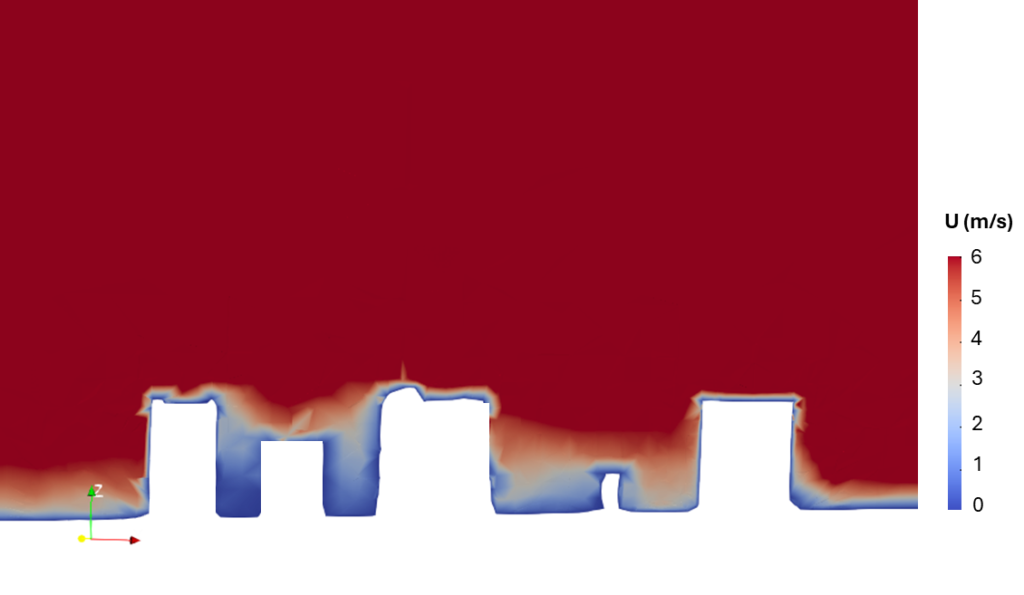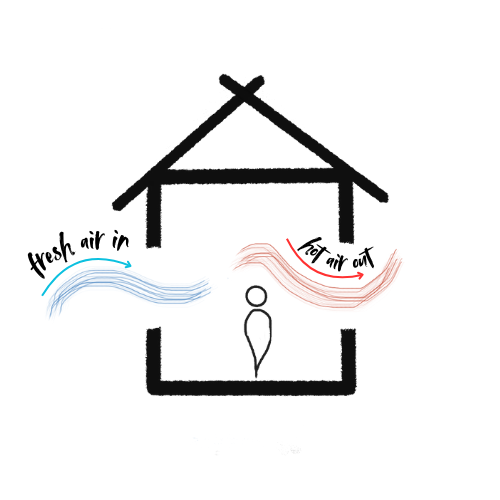CFD Simulation for External Natural Ventilation
Mastering the use of CFD simulation (Computational Fluid Dynamics) in architectural and urban projects allows detailed insight into the complex interaction of breezes and winds as they navigate through buildings, streets, and natural barriers.
Urban wind patterns are anything but predictable, diverted and redirected by the countless forms of the built environment. Professional wind analysis has become essential for sustainable and comfortable projects.
Why Wind Simulation is Essential
Wind Impacts on the Built Environment
- Occupant thermal comfort: Inadequate ventilation can result in stuffy environments or unwanted draughts
- Energy efficiency: Effective natural ventilation reduces dependence on mechanical systems
- Structural safety: Intense winds can cause excessive pressure on façades
- Air quality: Adequate circulation removes pollutants and excessive humidity
CFD Architecture Fundamentals
What is CFD Simulation?
CFD architecture uses complex mathematical equations to model fluid (air) behaviour around and through buildings. This technology enables:
3D Airflow Visualisation:
- Wind velocity patterns
- Pressure and suction zones
- Recirculation areas
- Stagnation points
Precise Quantitative Analysis:
- Specific velocities at each point
- Pressures on building surfaces
- Internal air renewal rates
- Thermal comfort indices
Impact of Wind Speed on the Outdoor Environment
Wind speed shapes the outdoor environment in ways we perceive consciously and subconsciously. As breezes traverse urban spaces, they blend with the structural landscape, influencing the sensory experience of those present. In outdoor areas, wind speed can modify temperatures, disperse pollutants, and significantly affect comfort levels.
Analysis using wind CFD simulation tools becomes essential for assessing how wind behaviour impacts external ventilation. Increased wind movement drives natural ventilation, bringing fresh air to spaces often stifled by urban clutter. This injection of airflow helps dissipate excess heat and maintains air quality by diluting pollutants. As urban planners harness these insights, they carve pathways for winds to flow, thus promoting sustainable environments that embrace the benefits of natural ventilation strategies.
Furthermore, wind CFD simulation contributes to understanding how wind speed enhances convective cooling, a natural process essential for thermal comfort in outdoor and semi-outdoor environments. By comprehending and utilising wind mechanics, architects and designers optimise outdoor spaces for functionality and human comfort. CFD tools thus become indispensable for those committed to enriching outdoor environments, as these simulations enable informed decisions about the design and orientation of open spaces to maximise the beneficial effects of prevailing winds.
Professional Wind Analysis Methodology

Professional wind analysis requires a structured and scientific approach to ensure precise and applicable results. The process includes several fundamental steps, from data collection to solution implementation. Below, I have listed some points to be considered when conducting this analysis:
1. Climate Data Collection
Essential Data:
- Local wind rose (direction and frequency)
- Seasonal average velocities
- Gust and extreme wind data
- Vertical wind profile (power law)
Data Sources:
- Local meteorological stations
- International climate databases
- Site-specific measurements (when necessary)
2. Detailed Digital Modelling
3D Model Creation:
- Precise geometry of proposed building
- Urban context within 500-1000m radius
- Topography and landscape elements
- Relevant façade details (balconies, eaves, etc.)
Computational Mesh:
- Progressive refinement near surfaces
- Adequate density to capture gradients
- Mesh quality verification
3. Simulation Setup
Physical Parameters:
- Turbulence model (k-ε, k-ω SST, LES)
- Appropriate boundary conditions
- Fluid properties (air density, viscosity)
Analysis Scenarios:
- Predominant winds (summer/winter)
- Extreme situations (storms)
- Different heights and orientations
Software and Tools for Computational Fluid Dynamics (CFD) Simulation
Here are some specific software and tools that are widely recognized for their ability to provide computational fluid dynamics (CFD) wind simulation. These software and tools are indispensable for a variety of applications, from modeling wind flow around buildings and structures to predicting weather patterns.
Natural Ventilation Simulation: Practical Applications
The application of natural ventilation simulation in real projects allows tangible benefits to be obtained at different scales, from individual residences to urban planning. This section explores how CFD wind analysis can be implemented in specific contexts, demonstrating its versatility and positive impact on the built environment. Through practical cases, we will see how simulation data translates into effective solutions to improve thermal comfort, reduce energy consumption and optimise building performance.
Single-Family Residences
Cross-Ventilation Optimisation:
- Strategic window positioning
- Opening sizing
- Creating preferential air paths
Case Study – House in São Paulo:
- Problem: Lack of natural ventilation on upper floor
- CFD Solution: Window repositioning and zenith opening creation
- Result: 60% improvement in air renewal
Commercial Buildings
Open Space Comfort Analysis:
- Atria and entrance halls
- Terraces and social areas
- External envelope (pedestrian comfort)
Integration with Mechanical Systems:
- Grille location optimisation
- HVAC system load reduction
- Hybrid ventilation strategies
Urban Planning
Microclimate Studies:
- Wind corridors between buildings
- Urban stagnation zones
- Impact of new developments
Natural Ventilation Simulation: Economic Benefits
The implementation of natural ventilation strategies through CFD simulations not only improves environmental comfort, but also offers significant economic advantages both in the short and long term. Therefore, the tangible financial benefits of optimised natural ventilation have become increasingly relevant in a context of growing concern with energy efficiency and sustainability. Moreover, detailed analysis of these economic benefits demonstrates the potential return on investment that CFD simulations can provide to building owners and managers.
Operational Cost Reduction
- Air conditioning: 30-50% energy savings
- Maintenance: Less wear on mechanical equipment
Property Valuation
- Greater comfort and occupant satisfaction
- Compliance with future regulations
The economic benefits of simulated natural ventilation go far beyond immediate energy consumption savings. The enhancement of property value, the reduction of maintenance costs and the preparation for future regulatory requirements represent significant competitive advantages in the market. Investing in CFD simulations for natural ventilation optimisation proves to be, therefore, not only an environmentally responsible decision, but also financially strategic, ensuring consistent returns throughout the entire useful life of the building.







One Comment